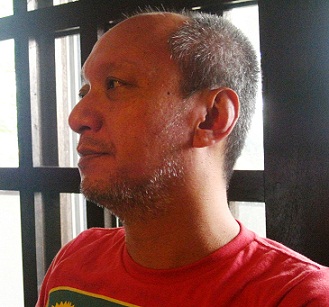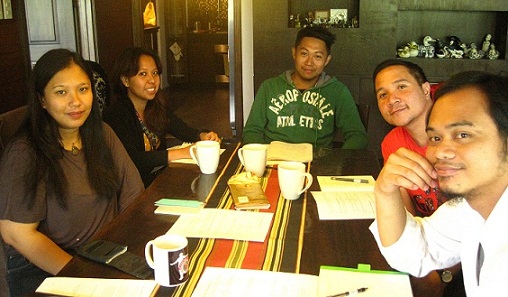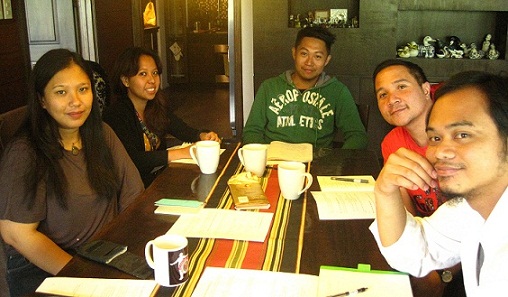Text and photos by ELIZABETH LOLARGA
 LIKE any other artistic genre, film is a way of “telling our stories to reflect the human experience.”
LIKE any other artistic genre, film is a way of “telling our stories to reflect the human experience.”
Scriptwriter-director Martin Masadao, whose debut film Anac Ti Pating won Best Picture and Best Actor honors at last year’s Sineng Pambansa Festival in Davao City, emphasized this at a recent film writing workshop in Baguio City.
Organized by the Baguio Writers Group, the workshop trained newbie screen writers in formatting their scripts, fleshing out protagonists, shaping plots towards the goal of making the viewer/reader want to watch the movie.
Masadao, also an essayist, production and art director, said a screenplay could be a writer’s original idea based on a real story or person, or it could be an adaptation from a previously published work. The script could be for a short film (from three minutes to as long as 59 minutes) or a feature-length one (over an hour).
In drawing up the cast of characters, the writer could give each a short description to include age, their personality (“a cold, uncaring mother”), sex, religion, socioeconomic class, even the zodiac sign if it reveals what the person is like.
Using the five senses in describing a character helps. Masadao said the character might reek of adobo or of Downy powder or have a shrill voice and rough hands.
He said, “You have to love your characters so much as though they’re your best friends. If something happens to your character, you can get affected. Don’t make them black and white, or they end up as spoofs. Show their flaws, how human they are. Loving a character doesn’t mean he or she is a good one. Think of Hannibal Lechter, the cannibal.”
To develop a character extensively, he suggested a careful selection of a name so it would be significant. He cited memorable names of film characters like Asyong Salonga, Facifica Falayfay, Bona, Forrest Gump.
He warned against using stereotypes that are common in Filipino movies where the protagonist is a fair, rich, mestiza woman with brown hair while the antagonist is dark and scarred. “Make the character multi-dimensional so the viewer is enchanted,” he said.
 What has always worked for him is an outline. From there a writer can proceed to plot out the story and break it up later into sequence, time of day, specify if the setting is in the interior or exterior and specific locale where the story is happening. The camera directions aren’t needed because this is the director’s and cinematographer’s call.
What has always worked for him is an outline. From there a writer can proceed to plot out the story and break it up later into sequence, time of day, specify if the setting is in the interior or exterior and specific locale where the story is happening. The camera directions aren’t needed because this is the director’s and cinematographer’s call.
Masadao said judges of film festival competitions like to read scripts “like a story (because) it’s a writer’s vision. It’s how you see your movie. You don’t tell how the director or editor will do the film.”
He said by adding up all the film’s sequences, the writer could estimate how long the work would run, adding that one written page was more or less equivalent to two minutes on film. At least 60 sequences make up a full-length film, and the easiest way to find out if it has realized its full length is to read the script casually.
For the story the basic element that moves it is conflict which can be internal (e.g., character is insecure or mentally disturbed) or exterior (an accident or an exchange of blows). Or it can be an act of God like a tsunami or a tornado. Or it can be all three. Sub-plots can be included to move with the conflict.
Masadao said in a story, change is involved and the character deals with it, wants it or not, adapts to it or prefers the status quo while the characters around him react to his reaction. Like in a traditional story, he added that “each sequence builds up to the climax followed by a denouement. Or you can choose to leave the story hanging. In each scene the intention must be clear, it must deepen the plot and reveal character. The conflict can be resolved in the end, or it can be open-ended, or the kind that will be talked about by viewers for days.”
The screen writer can enhance his vision by describing the plot or costume, if these will help the story. “Write it the way you see it,” the young director said. The writer can do “live readings to see if the dialogue sounds natural. Improvisations with trusted friends help,” particularly if the writer faces difficulties in writing.
With independently produced Filipino films making it to the short list of international festivals in Cannes, Venice and so on, Masadao said we have a place in world cinema because the trend is moving away from Hollywood movies whose goals are mainly entertainment and profit and towards films that push “the whole human experience.”
